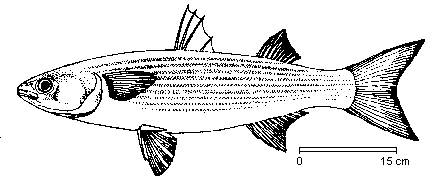
Liza ramada Risso, 1826

Synonyms: Mugil capito Cuvier, 1829; Mugil capito Bonaparte, 1834; Liza capito Popov, 1930; Mugil aramada Borcea, 1934; Liza tamada Buen, 1935
Common names: Engl: Thin lip grey mullet; Bulg: Kefal; Rom: Platarin; Russ: Kefal'; Turk: Pulatarina
Order: MUGILIFORMES
Family: MUGILLIDAE
Taxonomic descriptions: Body elongate, fusiform, slightly compressed from side to side; head short and flattened with a broad terminal mouth; very small teeth, hardly visible; upper lip thin (its greatest depth less than half the eye diameter) and smooth (without tubercles); two dorsal fins: the first short with 4 slender spines, taller than longer; the second dorsal fin as tall as the first one; ventral fins inserted in the mid-distance between pectoral and first dorsal fin; pectoral fin short; anal fin usually with 9 soft rays; caudal fin deeply forked; no external lateral line; scales large and adherent; scales on the top of the head extending forward to the anterior nostrils, (almost to the upper lip); eye is not covered by a thick adipose lid; at the base of pectoral fin there is a scaly appendix; colour on the back grey-dark brown, belly whitish-grey often with 6-7 lengthwise stripes. Size: maximum - 60 cm; common - 20-40 cm.
 IUCN
Status
IUCN
Status
World level:
Black Sea Regional level:
Subregion level: VU
Habitats type, Critical habitat, Limiting factors: Schools of L. ramada occur mostly in shallow water, especially in brackish and coastal lagoons of varying salinity. Common throughout the Mediterranean and along the northwestern coast of the Black Sea; also occurs in the eastern Atlantic, from southern Norway to Natal (South Africa).
Biology: A fast swimmer, leaping out of the water when disturbed; enters estuaries and rivers for feeding but spawns in the sea; juveniles often concentrate in the vicinity of freshwater outflows; feeds on minute bottom-living or planktonic organisms (diatoms, amphipods); also on suspended organic matter. Two spawning periods: first one slighter during spring and early in summer and the second one late in summer and autumn; pelagic eggs, spherical; yolk covered with black and yellow pigments.
Population trends: Caught mainly with gill nets, trammel nets, beach seines, cast nets and occasionally with purse seines. During recent decades the catches were decreasing in the northwestern part of the Black Sea. On the Romanian coasts it occurred more and more rarely. All mugilid species are included in a single statistical category: 1989 - Bulgaria -3 t; Romania - 8 t; Turkey - 2843 t;1990 - Bulgaria - 1 t; Turkey - 174 t; US - 26 t; 1991 - Bulgaria - 1 t; Turkey - 4026 t; US - 9 t.
Threats: The heavy pollution of the coastal waters threatens this species; poor condition of many coastal lagoons.
Conservation measures taken:
Conservation measures proposed: Reduce eutrophication and pollution.
References:
Compiled by: G.Radu, F.Verioti